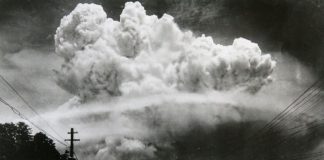
FLASHES OF CREATION
George Gamow, Fred Hoyle, and the Great Big Bang Debate
By Paul Halpern
The universe is changing. But scientists didn’t realize that a century ago, when astronomers like Edwin Hubble and Henrietta Leavitt discerned that other galaxies exist and that they’re hurtling away from the Milky Way at incredible speeds. That monumental discovery sparked decades of epic debates about the vastness and origins of the universe, and they involved a clash of titans, the Russian-American nuclear physicist George Gamow and the British astrophysicist Fred Hoyle.
In his new book, “Flashes of Creation,” Paul Halpern chronicles the rise of Gamow and Hoyle into leaders of mostly opposing views of cosmology, as they disputed whether everything began with a Big Bang billions of years ago.
Halpern, a physicist himself at the University of the Sciences in Philadelphia, skillfully brings their fascinating stories to light, out of the shadow of the overlapping quantum physics debates between Albert Einstein and Niels Bohr, which Halpern has written about in an earlier book. Halpern also poses fundamental questions about how science should be done. When do you decide, for example, to abandon a theory? Ultimately, his book seeks to vindicate Hoyle, who in his later years failed to admit his idea had lost.
Until these two bold theoreticians arrived, astrophysics had been stuck at an impasse. Scientists weren’t sure how to interpret Hubble’s observations, and no one understood how the universe created and built up chemical elements. “It is clear that the intuitive, seat-of-the-pants styles shared by Gamow and Hoyle were absolutely needed in their time,” Halpern writes.
Gamow and Hoyle make for a challenging “joint biography,” Halpern acknowledges, in part because their parallel stories so rarely intersected. They had only one significant in-person meeting, in the summer of 1956 in La Jolla, Calif., where Gamow had briefly served as a consultant for General Dynamics, the aerospace and defense company. They discussed many ideas in that coastal town, hanging out in Gamow’s white Cadillac, but for the most part, their debates took place in the pages of physics journals, newspapers and magazines, including Scientific American.
They also frequently appeared on early television and radio programs, becoming among the first well-known science communicators, paving the way for Carl Sagan, Neil deGrasse Tyson, Bill Nye, Carolyn Porco, Pamela Gay and others today. Hoyle wrote the science fiction novel “The Black Cloud” and the television screenplay “A for Andromeda,” while Gamow produced “One, Two, Three … Infinity” and the Mr. Tompkins series, whose main character’s predicaments illustrated aspects of modern science.
For years, their dueling theories — a Big Bang origin of matter and energy (championed by Gamow) versus a steady-state universe that created matter and energy through quantum fluctuations (championed by Hoyle) — remained highly speculative. Initially, the Big Bang theory predicted a universe only a couple billion years old, which conflicted with observations of the sun and other stars, known to be much older. Physicists were evenly divided between the two.
But that changed as more evidence emerged, and a key discovery eventually seemed to settle the debate. In 1964, the astronomers Arno Penzias and Robert Wilson noticed a constant signal of radio static with the Holmdel Horn Antenna in New Jersey. After ruling out possible experimental sources of noise (including pigeons and their droppings on the antenna), they deduced that the radio hiss had a cosmic origin. They and their colleagues eventually realized the signal came from relic radiation from the hot fireball of the early universe.
After that, the Big Bang theory quickly became consensus in the field. While Hoyle’s steady-state idea eventually failed, he made many other significant contributions, especially involving stellar processes and supernova explosions, which he showed could fuse chemical elements into heavier atoms and produce nitrogen, oxygen, carbon and more. In explaining this, and throughout the book, Halpern provides many helpful metaphors and analogies. He also reminds readers that Hoyle, Gamow and their fellow theoretical physicists made these accomplishments well before the heyday of supercomputers.
Halpern doesn’t shy away from the characters’ flaws. In particular, he shows how Hoyle’s work later in life lay on the fringes of physics, including his controversial “panspermia” hypothesis, that organic material and even life on Earth came from colliding comets, and his unsuccessful attempts to revive steady-state theory. But this shouldn’t cast a pall over his legacy.
Hoyle’s investment in the theory raises important philosophical and sociological questions about when we should consider an idea proven. It’s also the sort of quandary that threads its away through contemporary debates among physicists: about dark matter versus modified gravity theories; about what dark energy is and how the universe’s “inflation” happened moments after the Big Bang; and about a persistent discrepancy in measurements of the universe’s expansion rate, known as the “Hubble tension.” Halpern unfortunately gives only brief mention to these active areas of research, which owe a lot to Gamow and Hoyle.
At one point in the book, Halpern relates a conversation he had with Geoff Burbidge, a colleague of Hoyle’s who also continued to support a steady-state model. Cosmology needed alternatives, he argued, not lemmings following their leader over a cliff.







